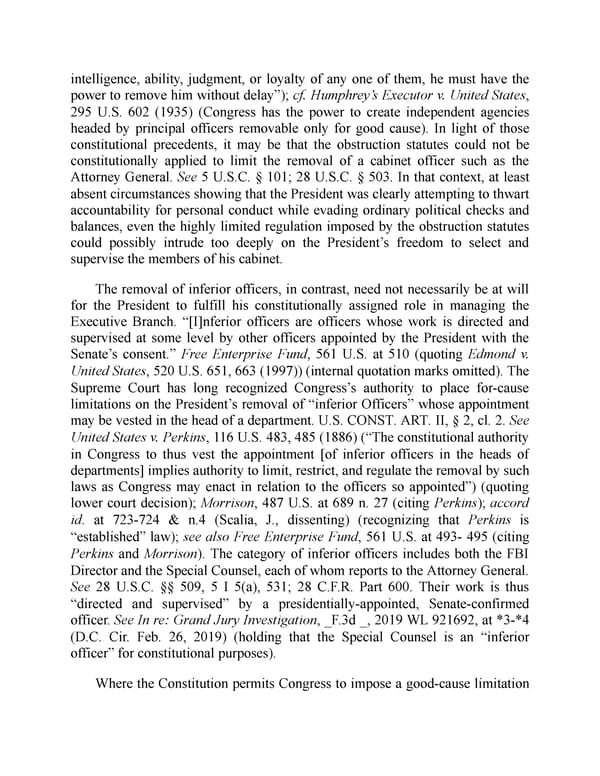intelligence, ability, judgment, or loyalty of any one of them, he must have the power to remove him without delay”); cf. Humphrey’s Executor v. United States, 295 U.S. 602 (1935) (Congress has the power to create independent agencies headed by principal officers removable only for good cause). In light of those constitutional precedents, it may be that the obstruction statutes could not be constitutionally applied to limit the removal of a cabinet officer such as the Attorney General. See 5 U.S.C. § 101; 28 U.S.C. § 503. In that context, at least absent circumstances showing that the President was clearly attempting to thwart accountability for personal conduct while evading ordinary political checks and balances, even the highly limited regulation imposed by the obstruction statutes could possibly intrude too deeply on the President’s freedom to select and supervise the members of his cabinet. The removal of inferior officers, in contrast, need not necessarily be at will for the President to fulfill his constitutionally assigned role in managing the Executive Branch. “[I]nferior officers are officers whose work is directed and supervised at some level by other officers appointed by the President with the Senate’s consent.” Free Enterprise Fund, 561 U.S. at 510 (quoting Edmond v. United States, 520 U.S. 651, 663 (1997)) (internal quotation marks omitted). The Supreme Court has long recognized Congress’s authority to place for-cause limitations on the President’s removal of “inferior Officers” whose appointment may be vested in the head of a department. U.S. CONST. ART. II, § 2, cl. 2. See United States v. Perkins, 116 U.S. 483, 485 (1886) (“The constitutional authority in Congress to thus vest the appointment [of inferior officers in the heads of departments] implies authority to limit, restrict, and regulate the removal by such laws as Congress may enact in relation to the officers so appointed”) (quoting lower court decision); Morrison, 487 U.S. at 689 n. 27 (citing Perkins); accord id. at 723-724 & n.4 (Scalia, J., dissenting) (recognizing that Perkins is “established” law); see also Free Enterprise Fund, 561 U.S. at 493- 495 (citing Perkins and Morrison). The category of inferior officers includes both the FBI Director and the Special Counsel, each of whom reports to the Attorney General. See 28 U.S.C. §§ 509, 5 I 5(a), 531; 28 C.F.R. Part 600. Their work is thus “directed and supervised” by a presidentially-appointed, Senate-confirmed officer. See In re: Grand Jury Investigation, _F.3d _, 2019 WL 921692, at *3-*4 (D.C. Cir. Feb. 26, 2019) (holding that the Special Counsel is an “inferior officer” for constitutional purposes). Where the Constitution permits Congress to impose a good-cause limitation
 Mueller Report PDF Page 506 Page 508
Mueller Report PDF Page 506 Page 508